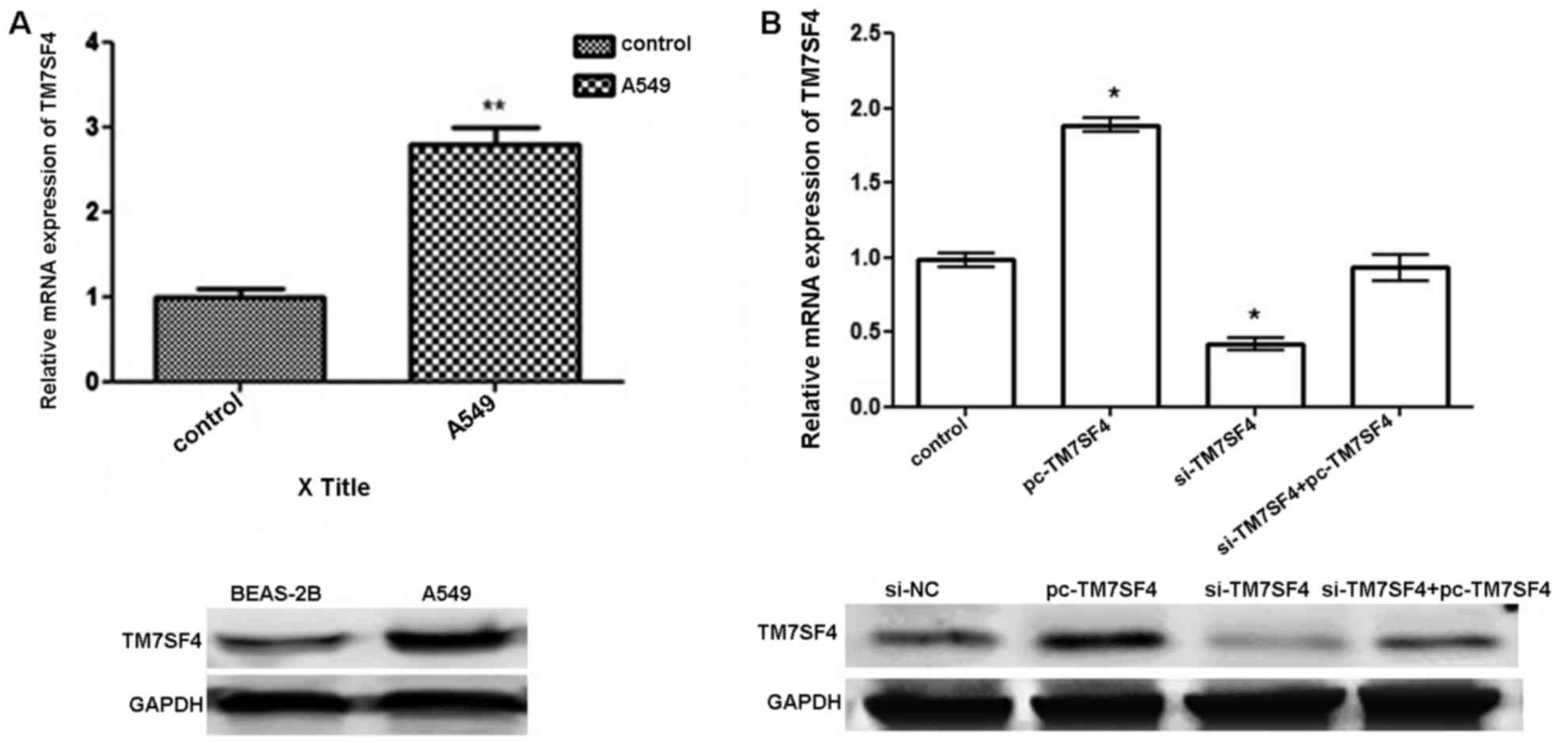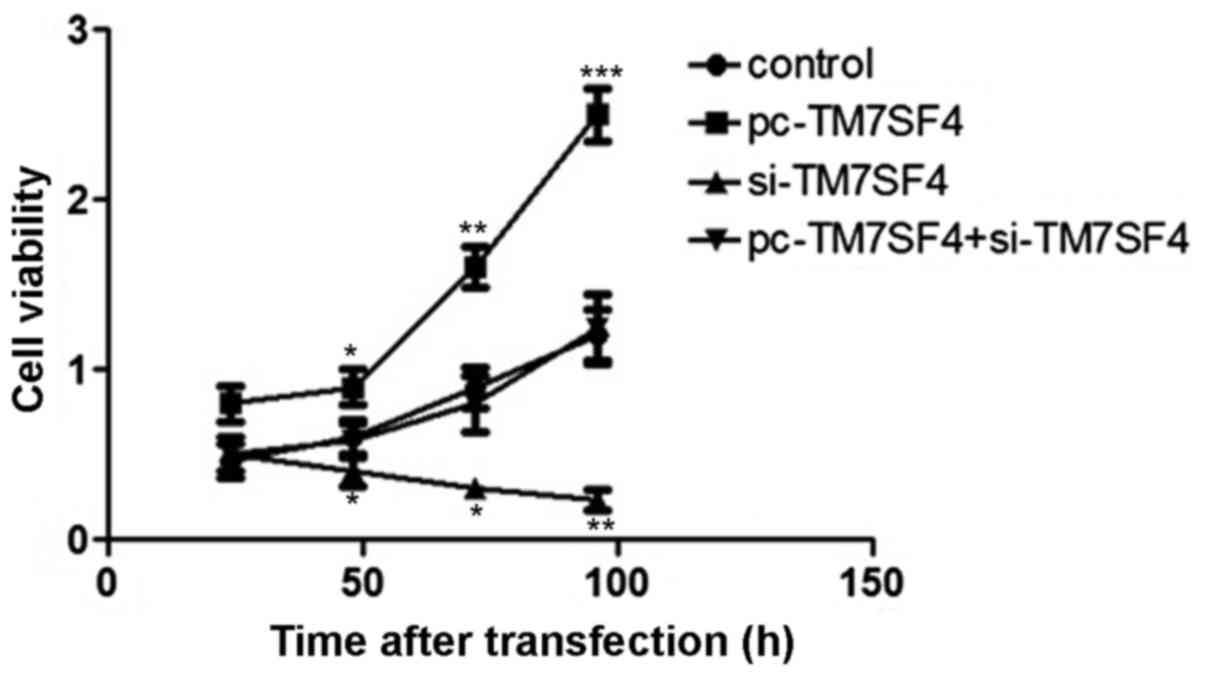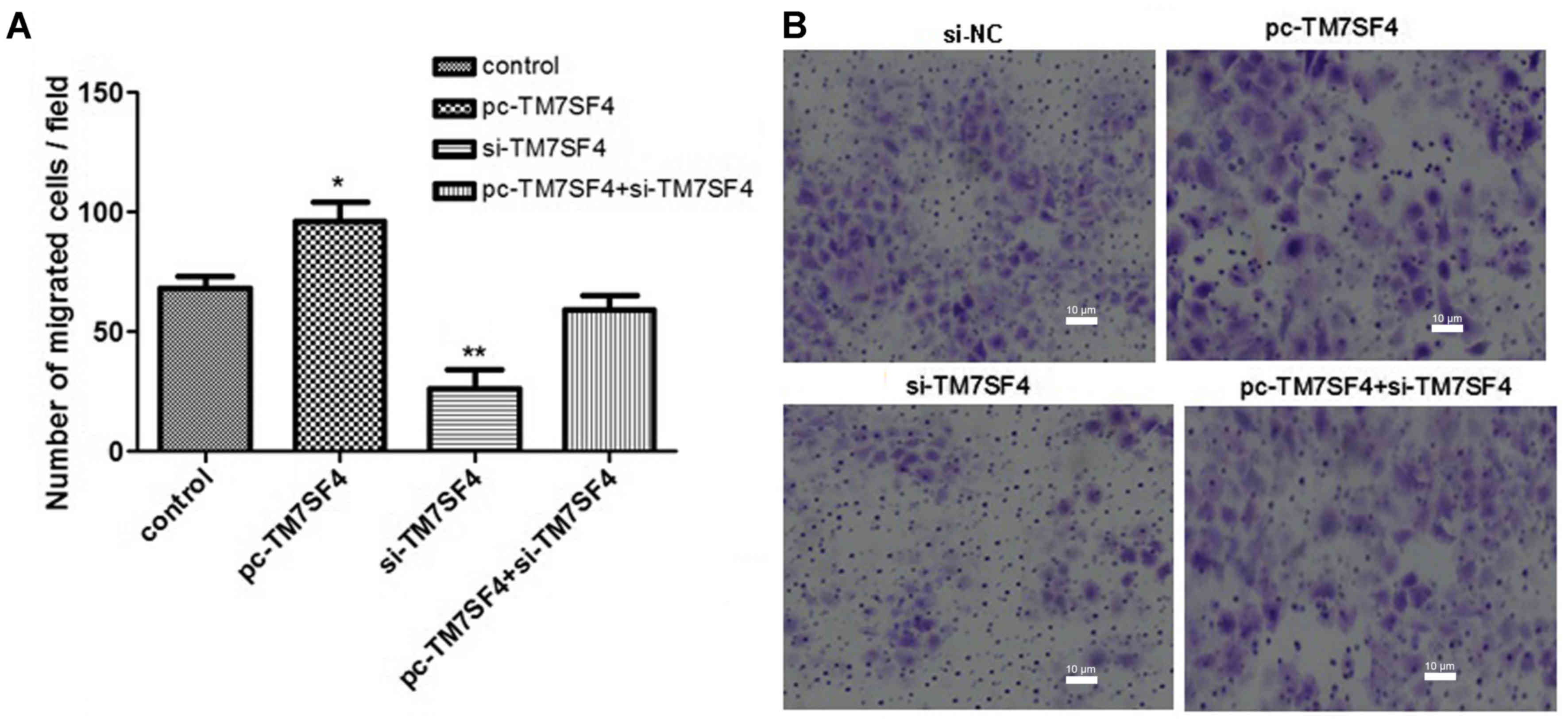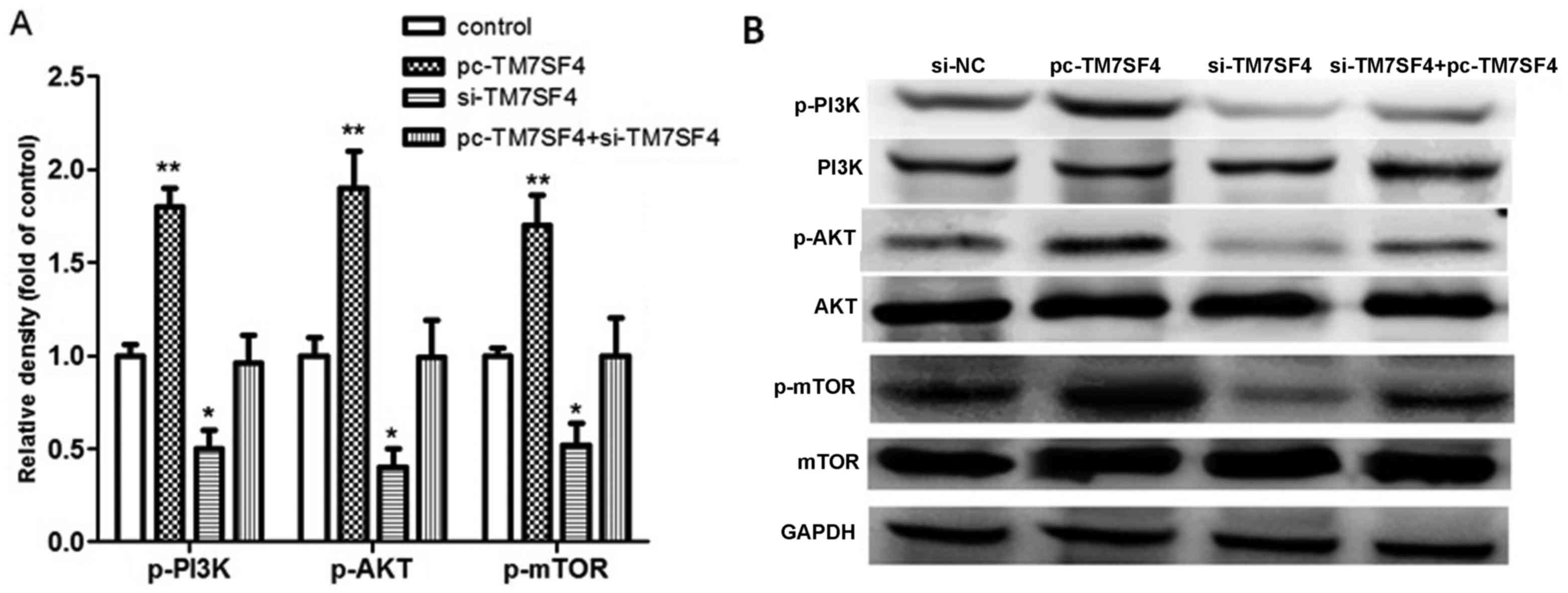Downregulation of TM7SF4 inhibits cell proliferation and metastasis of A549 cells through regulating the PI3K/AKT/mTOR signaling pathway
- Authors:
- Published online on: August 22, 2017 https://doi.org/10.3892/mmr.2017.7324
- Pages: 6122-6127
Abstract
Introduction
Lung cancer is a type of malignant tumor, which causes serious damage to human health (1). In previous years, the morbidity and mortality rates of lung cancer have significantly increased, and the morbidity and mortality rates of men with lung cancer are the highest among malignant tumor types, whereas among women it is the second highest (2,3). Metastasis occurs readily in lung cancer and can transfer to numerous regions of the body, causing serious and life-threatening complications, leading to normal tissue destruction (4,5). However, the incidence of lung cancer metastasis is relatively complex and the pathogenesis remains to be fully elucidated.
Transmembrane 7 superfamily member 4 (TM7SF4) is a type of transmembrane protein encoded by the TM7SF4 gene, which is present predominantly in dendritic cells, and is involved in biological processes, which include cell fusion, cell differentiation and immunity homeostasis (5,6). It has been shown that TM7SF4 is abnormally expressed in thyroid cancer, breast cancer and several other diseases, and accumulated evidence suggests that TM7SF4 is key in a variety of prevalent types of cancer (7). In addition, TM7SF4 has a marked effect on the occurrence of tumor development, and the roles of TM7SF4 in these prevalent types of cancer have attracted significant attention, however, its role in the molecular pathogenesis underlying lung cancer remains to be elucidated (7,8).
Phosphatidylinositol 3-kinase (PI3K) and AKT consist of multiple isoforms, and the PI3K/Akt pathway can regulate cellular processes as diverse as cell growth, survival, proliferation and migration (9,10). PI3K/AKT has frequently been reported in investigations of signaling pathways in various types of cancer, including breast cancer, thyroid cancer, ovarian cancer and lung cancer (11–13).
The aim of the present study was to examine the correlation between the expression of TM7SF4 and cell proliferation and migration in lung cancer. Initially, the expression levels of TM7SF4 were examined and compared between the A549 lung cancer cell line and normal cell lines using reverse transcription-quantitative polymerase chain reaction (RT-qPCR) analysis. The results confirmed its high expression of TM7SF4 in lung cancer. Accordingly, the proliferation and migration of lung cancer cells, and its possible molecular mechanism were investigated. The results demonstrated that the inhibition of TM7SF4 decreased cell viability and migration, whereas the overexpression of TM7SF4 increased cell proliferation. Therefore, it was concluded that TM7SF4 promoted cell viability and migration. For further analysis, the signaling pathway of TM7SF4 in the regulation of lung cancer cells was investigated, and the results revealed that TM7SF4 promoted cell viability by modulating activation of the PI3K/Akt pathway in the A549 cells. Accordingly, the overexpression of TM7SF4 promoted the expression of phosphorylated (p-)PI3K, p-AKT and p-mammalian target of rapamycin (mTOR). Taken together, these results provide opportunities, a theoretical basis and novel insights for further investigation and the clinical development of novel treatment strategies for lung cancer.
Materials and methods
Cell lines and cell transfection
The BEAS-2B human normal lung epithelial cell line and A549 lung cancer cell line were obtained from the American Type Culture Collection (Manassas, VA, USA). All cell lines were cultured at 5% CO2 and at 37°C according to the manufacturer's protocol. The TM7SF4 overexpression and silencing vectors were constructed by Sangon Biotech Co., Ltd. (Shanghai, China). A silencing vector containing no silenced TM7SF4 sequence was transfected into the A549 cells as a control. Cell transfection was performed using Lipofectamine 2000 reagent according to the manufacturer's protocol (Invitrogen; Thermo Fisher Scientific, Inc., Waltham, MA, USA) and then incubated for various durations, including 25, 50, 75 and 100 h.
3-(4,5-dimethylthiazol-2-yl)-2,5-diphenyltetrazolium bromide (MTT) assay
The cells were cultured on 12-well plates to a density of 5×104 cells/well. For the MTT assays, the cells were cultured on 96-well culture plates, and seeded at 5×103 cells/well. The cells were then incubated for various durations, as stated above. Cell viability was assayed by adding 20 µl of 10 mg/ml MTT (Sigma-Aldrich; Merck Millipore, Darmstadt, Germany) to 0.2 ml of culture medium, followed by incubation for 3 h at 37°C. The medium was then removed, and the MTT formazan product was dissolved in 150 µl DMSO, followed by measuring the optical density at 590 nm with a Multiskan EX microplate reader (Thermo Fisher Scientific, Inc.). Three independent assays were performed (14).
Cell migration and invasion assay
Cell migration and invasion were evaluated using Transwell migration chambers (8 µm pore size; Corning Incorporated, Corning, NY, USA). The membranes for the invasion assay were coated with a diluted ECM solution (Sigma-Aldrich; Merck Millipore) and then air-dried at 4°C. Following transfection, the cells (5×104 cells/well) were seeded with serum-free medium in the upper portion of a chamber. Medium containing 10% FBS (Invitrogen; Thermo Fisher Scientific, Inc.) was added to the lower chamber, served as a chemoattractant. After 24 or 48 h of incubation at 37°C, the non-invaded cells on the top of the membrane were scraped and removed using cotton swabs, whereas the invaded cells were fixed, stained with Diff-Quik and then counted using light microscopy.
RT-qPCR analysis
Total RNA was extracted from the tissue samples or cultured cells using TRIzol reagent (Takara Bio Inc., Otsu, Japan). The concentration and purity of the isolated RNA was then determined using an SMA 400 UV-VIS spectrophotometer (Merinton, Shanghai, China). Purified RNA (0.5 µg/µl) was then mixed with nuclease-free water and used for cDNA synthesis with the PrimerScript first strand cDNA synthesis kit (Invitrogen; Thermo Fisher Scientific, Inc.). The expression levels of targets in the cells were measured in an Eppendorf Mastercycler (Brinkman Instruments, Westbury, NY, USA) using the SYBR ExScriptqRT-PCR kit (Takara Biotechnology Co., Ltd., Dalian, China) at a standard final volume of 20 µl, which contained the following: 1.5 µl cDNA, 10 µl SYBR Premix EX Taq, 1 µl of forward primer (10 µm), 1 µl reverse primer (10 µm) and 6.5 µl ddH2O with 30 cycles. The PCR profile was run under the following cycling conditions: An initial predenaturation step at 95°C for 5 min, followed by 40 cycles of denaturation at 95°C for 30 sec, annealing at 53°C for 30 sec, extension at 72°C for 1 min and a final extension at 72°C for 10 min. Each reaction was performed in triplicate, and the 2−ΔΔCq method (15) was used to determine the relative gene expression levels. Melting curve analysis of the amplification products was performed at the end of each PCR to confirm that only one product was amplified and detected. Glyceraldehyde 3-phosphate dehydrogenase was selected as the internal control for mRNA or long non-coding RNAs. The primers used for target amplification are in Table I.
Western blot analysis
The cells were washed once with PBS and lysed in radioimmunoprecipitation assay buffer (Sangon Biotech Co., Ltd., Shanghai, China) containing phenylmethanesufonyl fluoride (Sigma-Aldrich; Merck Millipore), and centrifuged at 8,000 × g for 10 min at 4°C. Supernatant was collected for the measurement of protein concentrations using a bicinchoninic acid assay kit (Pierce; Thermo Fisher Scientific, Inc.). A total of 50 µg protein in each sample was boiled for 10 min in SDS sample buffer, separated on a 12% gel and subjected to SDS-PAGE, prior to transfer onto nitrocellulose membranes (Whatman GmbH, Dassel, Germany). Membranes were blocked in 5% non-fat dry milk in TBST for 1 h at room temperature. Subsequently, membranes were incubated with the following primary antibodies: TM7SF4 (catalog no. ab96809), PI3K (catalog no. ab182651), AKT (catalog no. ab81283), mTOR (catalog no. ab87540) and GAPDH (catalog no. ab181603), at 1:1,000 dilution overnight at 4°C. These antibodies were purchased from Abcam, Cambridge, UK. The membranes were then washed with TBST and incubated with horseradish peroxidase-conjugated goat anti-rabbit secondary antibody (catalog no. ab6721) and goat anti-mouse secondary antibody (catalog no. ab6789) (1:2,000 dilution) for 2 h at room temperature. Protein bands were visualized using the WEST-ZOL-plus (iNtRON Biotechnology, Seoul, Korea) western blot detection system (16). The intensity of protein bands was quantified using Image J software (version 1.46; National Institutes of Health, Bethesda, MD, USA).
Statistical analysis
All experiments in the present study were performed three times independently. Data are expressed as the mean ± standard deviation and were analyzed using GraphPrism Prism 5.0 software (GraphPad Software, Inc., San Diego, CA, USA). An independent sample t-test was used for paired data significance calculation. Tukey's post hoc test was used to calculate the differences among groups. P<0.05 was considered to indicate a statistically significant difference.
Results
TM7SF4 expressed at high levels in lung cancer A549 cells
The results of the RT-qPCR analysis and western blot analysis revealed the expression of TM7SF4 at the mRNA level and protein level, respectively. As shown in Fig. 1A, the expression of TM7SF4 was significantly upregulated in the A549 cells, compared with the normal lung tissues and cell lines (P<0.01). As shown in Fig. 1B, the transfection with pc-TM7SF4 effectively upregulated the expression level of TM7SF4 in the A549 at the mRNA and protein levels. The transfection of cells with si-TM7SF4 successfully downregulated the expression level of TM7SF4 in the A549 cells.
Suppression of TM7SF4 inhibits cell proliferation
To determine the effect of the expression of TM7SF4 on A549 cell viability, an MTT assay was used to determine the proliferation rate of A549 cells following 25, 50, 75 and 100 h of transfection. The results showed that regulation of the expression of TM7SF4 stimulated the proliferation of A549 cells. The transfection of cells with si-TM7SF4 decreased A549 viability, compared with cells in the blank group (P<0.01; Fig. 2).
Suppression of TM7SF4 prevents A549 cell migration
In the subsequent experiments, A Transwell assay was used to examine the effects of TM7SF4 on A549 cell migration. The results, as shown in Fig. 3A and B, confirmed that the silencing of TM7SF4 significantly inhibited the migration ability of the A549 cells (P<0.01).
TM7SF4 regulates cell proliferation and migration by targeting the PI3K/AKT/mTOR pathway
To further determine the possible molecular mechanism underlying the effect of the abnormal expression of TM7SF4 on A549 cell biological processes, the expression levels of PI3K/AKT/mTOR signaling pathway-associated proteins were examined in the cells from each group. As shown in Fig. 4A, the overexpression of TM7SF4 increased the expression levels of p-PI3K, p-AKT and p-mTOR (P<0.01), therefore, TM7SF4 may be associated with p-PI3K/AKT pathway activation. Subsequent experiments using western blot analysis were performed to examine the expression of associated proteins. The results, as shown in Fig. 4B, confirmed that TM7SF4 regulated cell migration and invasion through the p-PI3K/AKT pathway.
Discussion
Lung cancer is one of the leading causes of mortality without an effective treatment strategy, the prevalence and mortality rates of which continue to increase rapidly worldwide (17,18). As a result, it is important to elucidate the molecular mechanisms underlying the promotion of cell proliferation, migration and signaling pathways in lung cancer cells for elucidation of treatments and therapeutic strategies.
TM7SF4 encodes a seven-pass transmembrane protein, and this protein regulates immunological functions, osteoclastogenesis and myeloid differentiation (19). TM7SF4 has been reported be important in Paget's disease of bone, papillary thyroid cancer and breast cancer, however, the association between TM7SF4 and lung cancer has not been reported (6,20). The present study investigated the expression of TM7SF4 in lung cancer and provided the first confirmation, to the best of our knowledge, that TM7SF4 was expressed at a high level in lung cancer cells, determined using RT-qPCR analysis.
The present study examined the association between TM7SF4 and cell viability, and migration. TM7SF4 was found to promote the viability and migration of the A549 cells, therefore, the possibly pathways were subsequently investigated.
Alterations of signaling pathways are important in the regulation of multiple cellular functions of lung cancer, including cell growth and proliferation (21–24). A previous study by Zhu et al confirmed that the AKT signaling pathway is involved in the intrinsic apoptosis of non small-cell lung cancer cells (25). In another report, microRNA-223 was identified as a potential therapeutic target for overcoming epidermal growth factor receptor-tyrosine kinase inhibitor resistance, owing to its function in inducing activation of the PI3K/AKT/mTOR signaling pathway in PC9/ER and PC9/CD133+ cells, which is responsible for the resistance of PC9/ER and PC9/CD133+ cells to erlotinib (26). Additionally, a study by Wan et al suggested that insufficient RFA activates tumor growth in vitro and in vivo via PI3K/AKT/mTOR signals (27).
In the present study, the AKT signaling pathway in lung cancer cells was investigated. Using the method of gene silencing, it was found that silencing TM7SF4 inhibited the proliferation and metastasis of lung cancer through regulating activation of the PI3K/AKT/mTOR signaling pathways. In particular, the results showed that the expression levels of p-PI3K, p-AKT and p-mTOR were activated when TM7SF4 was overexpressed, whereas the inhibition of TM7SF4 inhibited this response. Therefore, TM7SF4 was found to be important in the proliferation and metastasis of lung cancer. Taken together, the present study confirmed that TM7SF4 was upregulated in A549 lung cancer cells, and that the downregulation of TM7SF4 may have certain suppressive roles in the development and metastasis of lung cancer through suppressing activation of the PI3K/AKT/mTOR signaling pathway. These findings confirmed that TM7SF4 may be closely involved in the progression and development of lung cancer, and may be a novel therapeutic target for this disease. Insufficient mechanistic understanding has hindered the prognosis of lung cancer, however, the present study indicated a novel potential therapeutic approach to improve success in treating lung cancer via targeting the identified PIKT/AKT/mTOR signaling pathway. The present study provides a foundation for further elucidation of the role of TM7SF4 in lung cancer. Specific elements of the underlying mechanism require further validation experiments.
Acknowledgements
This study was supported by the Natural Science Foundation of Shandong Province, China (grant no. 2009ZRB14066).
References
|
D'Addario G, Früh M, Reck M, Baumann P, Klepetko W and Felip E; ESMO Guidelines Working Group, . Metastatic non-small-cell lung cancer: ESMO clinical practice guidelines for diagnosis, treatment and follow-up. Ann Oncol. 21 Suppl 5:v116–v119. 2010. View Article : Google Scholar : PubMed/NCBI | |
|
Ferlay J, Steliarova-Foucher E, Lortet-Tieulent J, Rosso S, Coebergh JW, Comber H, Forman D and Bray F: Cancer incidence and mortality patterns in Europe: Estimates for 40 countries in 2012. Eur J Cancer. 49:1374–1403. 2013. View Article : Google Scholar : PubMed/NCBI | |
|
Sherwood JL, Corcoran C, Brown H, Sharpe AD, Musilova M and Kohlmann A: Optimised pre-analytical methods improve KRAS mutation detection in circulating tumour DNA (ctDNA) from patients with non-small cell lung cancer (NSCLC). PLoS One. 11:e01501972016. View Article : Google Scholar : PubMed/NCBI | |
|
Quéré G, Descourt R, Robinet G, Autret S, Raguenes O, Fercot B, Alemany P, Uguen A, Férec C, Quintin-Roué I and Le Gac G: Mutational status of synchronous and metachronous tumor samples in patients with metastatic non-small-cell lung cancer. BMC Cancer. 16:2102016. View Article : Google Scholar : PubMed/NCBI | |
|
Zequn N, Xuemei Z, Wei L, Zongjuan M, Yujie Z, Yanli H, Yuping Z, Xia M, Wei W, Wenjing D, et al: The role and potential mechanisms of LncRNA-TATDN1 on metastasis and invasion of non-small cell lung cancer. Oncotarget. 7:18219–18228. 2016. View Article : Google Scholar : PubMed/NCBI | |
|
Donáth J, Speer G, Kósa JP, Árvai K, Balla B, Juhász P, Lakatos P and Poór G: Polymorphisms of CSF1 and TM7SF4 genes in a case of mild juvenile Paget's disease found using next-generation sequencing. Croat Med J. 56:145–151. 2015. View Article : Google Scholar : PubMed/NCBI | |
|
Chung PY, Beyens G, de Freitas F, Boonen S, Geusens P, Vanhoenacker F, Verbruggen L, Van Offel J, Goemaere S, Zmierczak HG, et al: Indications for a genetic association of a VCP polymorphism with the pathogenesis of sporadic Paget's disease of bone, but not for TNFSF11 (RANKL) and IL-6 polymorphisms. Mol Genet Metab. 103:287–292. 2011. View Article : Google Scholar : PubMed/NCBI | |
|
Valerio MS, Herbert BA, Griffin AC III, Wan Z, Hill EG and Kirkwood KL: MKP-1 signaling events are required for early osteoclastogenesis in lineage defined progenitor populations by disrupting RANKL-induced NFATc1 nuclear translocation. Bone. 60:16–25. 2014. View Article : Google Scholar : PubMed/NCBI | |
|
Safdari Y, Khalili M, Ebrahimzadeh MA, Yazdani Y and Farajnia S: Natural inhibitors of PI3K/AKT signaling in breast cancer: Emphasis on newly-discovered molecular mechanisms of action. Pharmacol Res. 93:1–10. 2015. View Article : Google Scholar : PubMed/NCBI | |
|
Ye Y, Tang X, Sun Z and Chen S: Upregulated WDR26 serves as a scaffold to coordinate PI3K/AKT pathway-driven breast cancer cell growth, migration, and invasion. Oncotarget. 7:17854–17869. 2016. View Article : Google Scholar : PubMed/NCBI | |
|
McAuliffe PF, Meric-Bernstam F, Mills GB and Gonzalez-Angulo AM: Deciphering the Role of PI3K/Akt/mTOR pathway in breast cancer biology and pathogenesis. Clin Breast Cancer. 10 Suppl 3:S59–S65. 2010. View Article : Google Scholar : PubMed/NCBI | |
|
Fu J, Lv H, Guan H, Ma X, Ji M, He N, Shi B and Hou P: Metallothionein 1G functions as a tumor suppressor in thyroid cancer through modulating the PI3K/Akt signaling pathway. BMC Cancer. 13:4622013. View Article : Google Scholar : PubMed/NCBI | |
|
Fumarola C, Bonelli MA, Petronini PG and Alfieri RR: Targeting PI3K/AKT/mTOR pathway in non small cell lung cancer. Biochemical Pharmacol. 90:197–207. 2014. View Article : Google Scholar | |
|
Lu L, Li C, Li D, Wang Y, Zhou C, Shao W, Peng J, You Y, Zhang X and Shen X: Cryptotanshinone inhibits human glioma cell proliferation by suppressing STAT3 signaling. Mol Cell Biochem. 381:273–282. 2013. View Article : Google Scholar : PubMed/NCBI | |
|
Livak KJ and Schmittgen TD: Analysis of relative gene expression data using real-time quantitative PCR and the 2(-Delta Delta C(T)) method. Methods. 25:402–408. 2001. View Article : Google Scholar : PubMed/NCBI | |
|
Nam KS, Oh S, Lee KM, Yoo SA and Shin I: CD44 regulates cell proliferation, migration, and invasion via modulation of c-Src transcription in human breast cancer cells. Cell Signal. 27:1882–1894. 2015. View Article : Google Scholar : PubMed/NCBI | |
|
Imogen L and Gillham CM: Chemotherapy for lung cancer. N Engl J Med. 346:14982002. View Article : Google Scholar : PubMed/NCBI | |
|
Shaw AT, Ou SH, Bang YJ, Camidge DR, Solomon BJ, Salgia R, Riely GJ, Varella-Garcia M, Shapiro GI, Costa DB, et al: Crizotinib in ROS1-rearranged non-small-cell lung cancer. N Engl J Med. 372:1963–1971. 2014. View Article : Google Scholar | |
|
Chung PY, Beyens G, Boonen S, Papapoulos S, Geusens P, Karperien M, Vanhoenacker F, Verbruggen L, Fransen E, Van Offel J, et al: The majority of the genetic risk for Paget's disease of bone is explained by genetic variants close to the CSF1, OPTN, TM7SF4, and TNFRSF11A genes. Hum Genet. 128:615–626. 2010. View Article : Google Scholar : PubMed/NCBI | |
|
Albagha OM, Wani S and Ralston SH: Identification of a functional variant in the TM7SF4 gene that is associated with susceptibility to Paget's disease of bone. Bone. 48:S882011. View Article : Google Scholar | |
|
Mino-Kenudson M and Mark EJ: Reflex testing for epidermal growth factor receptor mutation and anaplastic lymphoma kinase fluorescence in situ hybridization in non-small cell lung cancer. Arch Pathol Lab Med. 135:655–664. 2011.PubMed/NCBI | |
|
Feng N, Luo J and Guo X: Silybin suppresses cell proliferation and induces apoptosis of multiple myeloma cells via the PI3K/Akt/mTOR signaling pathway. Mol Med Rep. 13:3243–3248. 2016. View Article : Google Scholar : PubMed/NCBI | |
|
Zhang G, Wang C, Sun M, Li J, Wang B, Jin C, Hua P, Song G, Zhang Y, Nguyen LL, et al: Cinobufagin inhibits tumor growth by inducing intrinsic apoptosis through AKT signaling pathway in human nonsmall cell lung cancer cells. Oncotarget. 7:28935–28946. 2016. View Article : Google Scholar : PubMed/NCBI | |
|
Zhao XZ, Liu Y, Zhou LJ, Wang ZQ, Wu ZH and Yang XY: Role of estrogen in lung cancer based on the estrogen receptor-epithelial mesenchymal transduction signaling pathways. Onco Targets Ther. 8:2849–2863. 2015. View Article : Google Scholar : PubMed/NCBI | |
|
Zhu Q, Liang X, Dai J and Guan X: Prostaglandin transporter, SLCO2A1, mediates the invasion and apoptosis of lung cancer cells via PI3K/AKT/mTOR pathway. Int J Clin Exp Pathol. 8:9175–9181. 2015.PubMed/NCBI | |
|
Hu J, Boeri M, Sozzi G, Liu D, Marchianò A, Roz L, Pelosi G, Gatter K, Pastorino U and Pezzella F: Gene signatures stratify computed tomography screening detected lung cancer in high-risk populations. Ebiomedicine. 2:829–840. 2015. View Article : Google Scholar | |
|
Wan J, Wu W, Chen Y, Kang N and Zhang R: Insufficient radiofrequency ablation promotes the growth of non-small cell lung cancer cells through PI3K/Akt/HIF-1α signals. Acta Biochim Biophys Sin (Shanghai). 48:371–377. 2016. View Article : Google Scholar : PubMed/NCBI |













